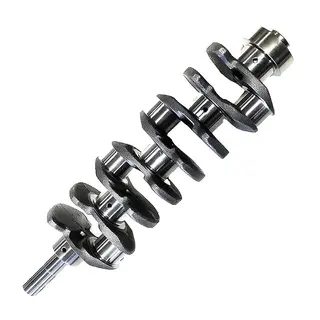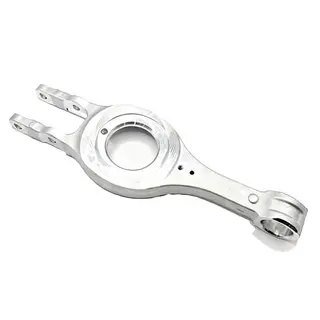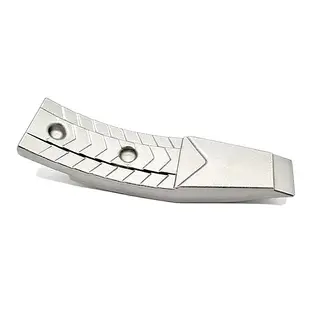The quality of automotive components directly affects the performance, safety, and service life of the whole vehicle. In modern automotive manufacturing, forging has become an important method for producing key components due to its excellent mechanical properties, dimensional accuracy, and material utilization. Through forging, metal materials can be plastically deformed into the required shapes while optimizing internal grain structure, improving the strength, toughness, and fatigue resistance of components. Therefore, mastering the entire process of automotive component forging, from preparation to post-processing and application, is of great significance for improving overall vehicle quality and production efficiency.
Before forging automotive components, full preparation must be done, which is as important as laying a solid foundation before building a house.
First, appropriate metal materials must be selected based on the specific requirements of the components. Different automotive components, due to their functions and usage environments, have different material performance requirements. For example, engine crankshafts need to withstand huge torque and impact forces, so high-strength alloy steels are generally chosen; while some small connecting parts can use lighter aluminum alloys. After selecting the material, heating treatment is also required. The purpose of heating is to improve the plasticity and forgeability of the material, making it easier to deform during forging and reducing stress concentration and cracking. The heating temperature is generally determined according to the type and performance requirements of the material, usually above the material's recrystallization temperature.
Dies are indispensable tools in the forging process, determining the shape and dimensional accuracy of components. Depending on the shape and complexity of the components, designing and manufacturing appropriate dies is crucial. The quality of the dies directly affects the quality and production efficiency of forged components. High-quality dies can ensure dimensional accuracy and surface quality, reduce subsequent machining processes, and lower production costs. At the same time, the durability of dies is also important; durable dies reduce replacement frequency and improve production efficiency.
Forging equipment is a key tool for implementing the forging process, including forging machines, heating equipment, and cooling devices. Forging machines apply pressure to the metal material, causing plastic deformation; heating equipment heats the material to the appropriate temperature; cooling devices are used to rapidly cool components after forging to improve their microstructure and performance. The selection and maintenance of these devices are very important, as their performance and accuracy directly affect the quality and production efficiency of forged components.
The forging process is the core stage of manufacturing automotive components. Heated metal materials are placed in dies and plastically deformed under applied pressure to produce the desired component shape. Depending on the forging temperature, forging can be divided into cold forging and hot forging.
Cold forging is performed at room temperature and is suitable for some low-carbon steels and alloy steels. The advantages of cold forging are that no heating equipment is needed, saving energy; production efficiency is high; and high dimensional accuracy and surface quality can be obtained. However, cold forging requires high material plasticity and forgeability. Because it is performed at room temperature, the resistance to deformation is relatively high, requiring greater forging pressure. Therefore, cold forging is usually used to manufacture small, simple-shaped components, such as bolts and pins.
Hot forging is performed at high temperatures and is suitable for high-carbon steel, alloy steel, stainless steel, and other materials. The advantages of hot forging are good material plasticity and forgeability, allowing the manufacture of complex-shaped and larger components. At high temperatures, the resistance to deformation is lower, and the required forging pressure is relatively smaller. Therefore, hot forging can produce large components that cold forging cannot, such as automotive crankshafts and connecting rods. However, hot forging requires heating equipment, consumes more energy, and places higher demands on dies, which must maintain good performance at high temperatures.
After forging, components need to undergo a series of processing steps to further improve their performance and quality.
The purpose of cooling is to rapidly cool the components to improve their microstructure and performance. Cooling methods include water cooling, oil cooling, and air cooling, chosen according to the material and component requirements. Water cooling is fast and can achieve high hardness and strength, but may generate high internal stress in components; oil cooling has a moderate speed and can achieve good toughness and dimensional stability; air cooling is slower, suitable for components with high dimensional accuracy requirements.
Forged components usually require trimming to remove excess material, burrs, and surface defects. Trimming methods include mechanical trimming and heat treatment trimming. Mechanical trimming is carried out by machining, such as turning and milling, and can accurately remove excess material, improving dimensional accuracy and surface quality. Heat treatment trimming is performed at high temperature to improve the component's microstructure and performance, relieve internal stresses, and enhance strength and toughness.
Some components also require heat treatment after forging. Heat treatment can improve the microstructure and performance of materials, enhancing strength and hardness. Common heat treatment methods include quenching, tempering, and normalizing. Quenching involves heating components to a certain temperature and rapidly cooling them to achieve high hardness and strength; tempering involves heating quenched components to a certain temperature and slowly cooling them to relieve quenching stress and achieve good toughness and strength; normalizing involves heating components to a certain temperature and air cooling to improve microstructure and performance, enhancing machinability.
To ensure forged components meet quality requirements, strict inspection is necessary. Common inspection methods include visual inspection, dimensional inspection, hardness testing, and mechanical property testing. Visual inspection checks for cracks, burrs, deformation, and other defects; dimensional inspection measures component sizes to ensure compliance with design drawings; hardness testing determines whether hardness meets design requirements; mechanical property testing, such as tensile and impact tests, evaluates strength, toughness, and other mechanical properties against standards.
Finally, surface treatment is performed to improve surface finish and corrosion resistance. Common methods include galvanization, coating, and electroplating. Galvanization applies a zinc layer to prevent rust; coating applies a layer of paint to improve corrosion resistance and aesthetics; electroplating deposits a metal layer, such as copper, nickel, or chromium, to enhance wear resistance and corrosion resistance.
Forged automotive components are widely applied in vehicle manufacturing due to their superior quality and performance. Major applications include:
The engine is the heart of the vehicle, and the quality of its components directly affects vehicle power and service life. Forged engine components include crankshafts, connecting rods, camshafts, and valves. Crankshafts are core components, converting piston reciprocation into rotational motion and delivering power. Because they must withstand high torque and impact, they are usually produced by hot forging to ensure sufficient strength and durability. Connecting rods connect pistons and crankshafts, transmitting motion, and require high strength and toughness; they are also made by hot forging. Camshafts and valves control engine intake and exhaust, with high precision and reliability, typically manufactured by cold or warm forging.
The transmission system transfers engine power to the wheels and includes gears, shafts, and clutch components. These parts require high strength, precision, and wear resistance. Forging ensures their quality and performance, enabling them to withstand long-term high-speed operation and high torque. For example, gear precision affects transmission efficiency and noise levels. Forged gears have accurate tooth profiles and dimensions, ensuring smooth and efficient transmission.
Suspension and steering systems, including control arms, steering knuckles, and tie rods, are critical for vehicle stability and handling. These components need sufficient strength and toughness to endure various loads and impacts during driving. Forging improves their performance, ensuring reliable operation under complex road conditions. For example, control arms connect wheels and chassis, bearing vertical and lateral loads; forged control arms enhance load capacity and service life.
Chassis and structural components, including axle beams, frame brackets, and cross members, require high strength and stability to support vehicle weight and loads. Forging increases strength and toughness, ensuring components meet operational requirements. For example, axle beams support wheels and transmit power; forged axle beams enhance load-bearing and fatigue resistance.
The brake system is critical for vehicle safety and includes caliper brackets and rotor hats. These components require high strength and thermal stability to ensure reliable braking. Forging improves performance, allowing normal operation under high temperature and load. For example, forged caliper brackets withstand high pressure and heat during braking, ensuring safety and reliability.
The forging process offers numerous advantages in automotive component manufacturing, making it indispensable:
Forging rearranges metal grains along the component profile, significantly enhancing strength and toughness. Forged components outperform cast or machined parts in fatigue resistance, impact resistance, and wear resistance. For critical engine components like crankshafts and connecting rods, forging ensures stable, reliable performance under long-term high-load operation, reducing damage and failure, and increasing overall vehicle reliability and service life.
Forging precisely controls component shape and dimensions. Accurate die design allows complex, high-precision parts, reducing subsequent machining and improving assembly quality. For example, warm forging combines hot and cold techniques to produce precise gears and bearings, meeting transmission system accuracy requirements.
Forging achieves high metal utilization, minimizing material waste. Compared to casting, metal flow in forging is more uniform, filling die cavities effectively and reducing material loss. Less machining stock is required afterward, further improving utilization, lowering production costs, and supporting sustainable development by reducing resource waste and environmental impact.
Forging can process various metals, including carbon steel, alloy steel, aluminum alloys, and stainless steel. This allows selection of suitable materials according to design and performance requirements, meeting usage demands under different conditions. For example, lightweight aluminum alloys can be forged for lighter, stronger components, enhancing fuel efficiency and vehicle performance.
In summary, forging demonstrates irreplaceable advantages in automotive component manufacturing. It ensures high strength, reliability, and precise dimensions, improves material utilization, and adapts to various materials and complex operating conditions. With the continuous development of automotive technology, forging processes are constantly optimized and innovated, providing reliable components for engines, transmissions, suspensions, brakes, and chassis, promoting the automotive industry toward higher performance, safety, and environmental sustainability.



